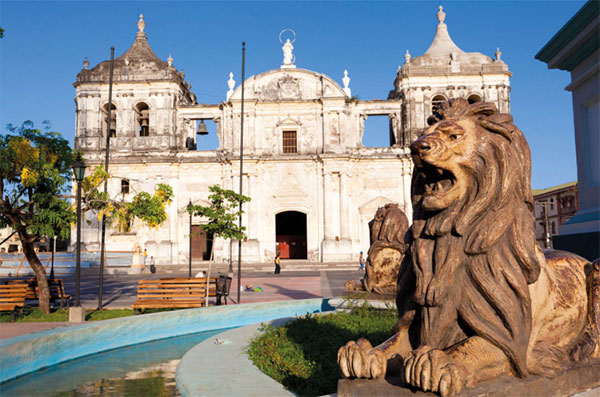THE UNITED FRUIT COMPANY
One of the most impressive ancient sites in Mesoamerica is Copán (for more information, click here), featuring some of the Mayan world’s greatest treasures. This restored Mayan city sits on the banks of the Río Copán, only 12km (8 miles) into Honduras from the Guatemalan border town of El Florido. An increasing number of visitors to Guatemala make a special detour to these superb ruins, whose carved stelae are widely considered the finest as yet found in the Maya world.
Around Flores
The small but spread-out village of El Remate ∞ [map] is another good base for exploring Tikal, with a burgeoning number of hotels. It is 30km (18.5 miles) from Santa Elena/Flores and particularly convenient if you are approaching the ruins from Belize.
About 3km (2 miles) from the center of the village is a small nature preserve, the Biotopo Cerro Cahuí (6.30am–dusk). The preserve is home to a remarkable diversity of plant life (mahogany, ceiba, and sapodilla trees, orchids and epiphytes), animals (spider and howler monkeys, armadillos, and ocelots) and particularly an exceptional quantity of birds, with hundreds of species recorded here.
Tikal
Entombed in dense jungle, where the inanimate air is periodically shattered by the roars of howler monkeys, the phenomenal, towering ruins of Tikal § [map] are one of the wonders of the Americas. Five magnificent temple-pyramids soar above the forest canopy, finely carved stelae and altars in the plaza eulogize the city’s glorious history, giant stucco masks adorn monuments, and stone-flagged causeways lead toward other ruined cities lying even deeper in the jungle.

Flores is a colonial town perched on an island.
Corrie Wingate/Apa Publications
Tikal’s scale is awesome. In the Classic period its population grew to almost 100,000. Trade routes connected the city with Teotihuacán (near modern-day Mexico City), the Caribbean and Pacific coasts. Temple IV was built to a height of around 65 meters (213ft), complete with its enormous roof comb. Exquisite jade masks, ceramics, jewelry, and sculptures were created. There were ball courts, sweat baths, colorfully painted royal palaces, and another 4,000 buildings to house the artisans, astrologers, farmers, and warriors of the greatest city of the Classic Maya civilization.
Most travelers concur that Tikal is the most visually sensational of all the Maya sites. To get the most out of your visit, try to stay overnight at one of the hotels close to the ruins, to witness the electric atmosphere at dawn and dusk when the calls of toucans, frogs, monkeys, and other mammals echo around the surrounding jungle. The temperature and humidity are punishing at any time of year, so make sure you take plenty of water, and also insect repellent.
Tikal history
Tikal is one of the oldest Maya sites: only some of the Mirador Basin sites and Cuello (in Belize) predate it. It’s located in the central lowland Maya zone, the cradle of Maya civilization, in a dense subtropical forest environment. The earliest evidence of human habitation at Tikal is around 700 BC, in the Preclassic period. By 500 BC the first simple structures were constructed, but Tikal would have been little more than a small village at this time and Nakbé, some 55km (34 miles) to the north, was the dominant power in the region.
By the time Tikal’s first substantial ceremonial structures were built (the North Acropolis and the Great Pyramid) around 200 BC, powerful new cities had emerged, above all the enormous El Mirador, 64km (40 miles) to the north and connected by a sacbé raised causeway.
By the start of the Classic period in AD 250, El Mirador and Nakbé had faded and Tikal had grown to be one of the most important Maya cities, along with Uaxactún. The great Tikal leader Great Jaguar Paw and his general Smoking Frog defeated Uaxactún in AD 376, bringing on an era when Tikal and rival ‘superpower’ Calakmul contested dominance of the Maya region for another two centuries. Huge advances were made in the study of astronomy, calendrics, and arithmetics under Stormy Sky (AD 426–57). But disaster struck in 562 when upstart Caracol (in Belize) defeated Double Bird of Tikal and forged a crucial alliance with Calakmul that was to humble Tikal for 120 years – no stelae at all were carved in this time.